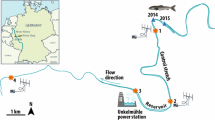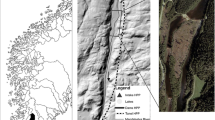Abstract
An accidental release of non-toxic waste from decommissioned wood pulp industry in the River Numedalslågen, Southern Norway, occurred in the upper part of the accessible stretches for anadromous fish during a study of migration behaviour of radio tagged Atlantic salmon (Salmo salar, n=32, body length 51–99 cm). The fish had completed the migration phase and initiated the resident phase characterised by little movement until spawning. When the wooden fibres and pulp were released, 16 of 32 (50%) salmon showed an immediate avoidance response. Six (19%) salmon moved upstream and 10 (31%) salmon moved downstream. Of the salmon moving downstream, eight (25%) moved all the way to sea (average 14.8 km). Four re-entered the River Numedalslågen, two entered a neighbouring river and two were not recorded later. Fish moving downstream but without moving to the sea, moved on average 5.3 km during the episode, whereas those moving upstream moved on average 6.7 km. All fish recorded after the episode (n=30) survived until the spawning season. The study demonstrates that fish in nature may show an evident avoidance response, even to non-toxic contaminants. For Atlantic salmon, the size of the spawning population may be reduced by fish leaving the river (13% left the river and never came back). Moreover, the dispersal of salmon to other rivers may increase, and the distribution of the spawning population within the contaminated river may shift.
Similar content being viewed by others
References
Atchison, G. J., Henry, M. G. and Sandheinrich, M. B.: 1987, ‘Effects of metals on fish behaviour: A review’, Environ. Biol. Fishes 18, 11–25.
Åtland, Å.: 1998, ‘Behavioural responses of brown trout, Salmo trutta, juveniles in concentration gradients of pH and Al: a laboratory study’, Environ. Biol. Fishes 53, 331–345.
Åtland, Å. and Barlaup, B. T.: 1995, ‘Avoidance of toxic mixing zones byAtlantic salmon (Salmo salar L.) and brown trout (Salmo trutta L.) in the limed River Audna, southern Norway’, Environ. Pollut. 90, 203–208.
Åtland, Å. and Barlaup, B. T.: 1996, ‘Avoidance behaviour of Atlantic salmon (Salmo salar L.) fry in waters of low pH and elevated aluminum concentration: Laboratory experiments’, Can. J. Fish. Aquat. Sci. 53, 1827–1834.
Cooke, S. J., Bunt, C. M. and Schreer, J. F.: 2004, ‘Understanding fish behaviour, distribution and survival in thermal effluents using fixed telemetry arrays: A case studie of smallmouth bass in a discharge canal during winter’, Environ. Manage. 33, 140–150.
Cooke, S. J., Hinch, S. G., Wikelski, M., Andrews, R. D., Kuchel, L. J., Wolcott, T. G. and Butler, P. J.: 2004, ‘Biotelemetry: A mechanistic approach to ecology’, Trends Ecol. Evol. 19, 334–343.
Dunkley, D. A. and Shearer, W. M.: 1982, ‘An assessment of the performance of a resistivity fish counter’, J. Fish Biol. 20, 717–737.
Goldstein, J. N., Woodward, D. F. and Farag, A. M.: 1999, ‘Movements of adult chinook salmon during spawning migration in a metals-contaminated system, Coeur d’Alene River, Idaho’, Trans. Am. Fish. Soc. 128, 121–129.
Gray, R. H.: 1983, ‘Behavioural response of fish to altered water quality: A review of selected examples with emphasis on salmonids’, Environ. Impact Assess. Rev. 4, 84–96.
Gray, R. H.: 1990, ‘Fish behaviour and environmental assessment’, Environ. Toxicol. Chem. 9, 53–67.
Harden Jones, F. R.: 1968, Fish Migration, Edward Arnold Ltd, London.
Hasler, A. D.: 1966, Underwater Guideposts: Homing of salmon, University of Wisconsin Press, Madison, WI.
Hawkins, A. D. and Smith, G. W.: 1986, ‘Radio-tracking observations on Atlantic salmon ascending the Aberdeenshire Dee’, Scott. Fish. Res. Rep. 36, 1–24.
Heggberget, T. G., Hansen, L. P. and Næsje, T. F.: 1988, ‘Within-river spawning migration of Atlantic salmon (Salmo salar)’, Can. J. Fish. Aquat. Sci. 45, 1691–1698.
Heggberget, T. G., Lund, R. A., Ryman, N. and Ståhl, G.: 1986, ‘Growth and genetic variation of Atlantic salmon (Salmo salar) from different sections of the River Alta, North Norway’, Can. J. Fish. Aquat. Sci. 43, 1828–1835.
Huntsman, A. G.: 1948, ‘Freshets and fish’, Trans. Am. Fish. Soc. 75, 257–266.
Økland, F., Erkinaro, J., Moen, K., Niemelä, E., Fiske, P., McKinley, R. S. and Thorstad, E. B.: 2001, ‘Return migration of Atlantic salmon in the River Tana: Phases of migratory behaviour’, J. Fish Biol. 59, 862–874.
Pickering, A. D. (ed.): 1981, Stress and fish, Academic Press Inc., London, 367 pp.
Saunders, R. L. and Sprague, J. B.: 1967, ‘Effects of coppper-zink mining pollution on a spawning migration of Atlantic salmon, Wat. Res. 1, 419–432.
Skogheim, O. K., Rosseland, B. O. and Sevaldrud, I. H.: 1984, ‘Deaths of spawners of Atlantic salmon (Salmo salar L.) in River Ogna, SW Norway, caused by acidified aluminium-reach water, Rep. Inst. Freshw. Res. Drottningholm 61, 195–202.
Skorobogatov, M. A. and Pavlov, D. S.: 1995, ‘Experimental studies on the effect of suspended particles on behaviour of roach, Rutilus rutilus, in running water, J. Ichtyol. 35, 121–129.
Stabell, O. B.: 1984, ‘Homing and olfaction in salmonids: A critical review with special reference to the Atlantic salmon’, Biol. Rev. 59, 333–388.
Thorstad, E. B., Fiske, P., Aarestrup, K., Hvidsten, N. A., Hårsaker, K., Heggberget, T. G. and Økland, F.: 2004, ‘Upstream migration of Atlantic salmon in three regulated rivers’, Proceedings of the Fifth Conference on Fish Telemetry held in Europe, in press.
Thorstad, E. B. and Heggberget, T. G.: 1998, ‘Migration of adult Atlantic salmon (Salmo salar); the effects of artificial freshets’, Hydrobiologia 371/372, 339–346.
Thorstad, E. B., Heggberget, T. G. and Økland, F.: 1998, ‘Migratory behaviour of adult wild and escaped farmed Atlantic salmon, Salmo salar L., before, during and after spawning in a Norwegian river’, Aquacult. Res. 29, 419–428.
Thorstad, E. B., Økland, F. and Finstad, B.: 2000, ‘Effects of telemetry transmitters on swimming performance of adult Atlantic salmon’, J. Fish Biol. 57, 531–535.
Webb, J.: 1989, ‘The movements of adult Atlantic salmon in the River Tay’, Scott. Fish. Res. Rep. 44, 1–32.
Author information
Authors and Affiliations
Corresponding author
Rights and permissions
About this article
Cite this article
Thorstad, E.B., Forseth, T., Aasestad, I. et al. In Situ Avoidance Response Of Adult Atlantic Salmon To Waste From The Wood Pulp Industry. Water Air Soil Pollut 165, 187–194 (2005). https://doi.org/10.1007/s11270-005-5418-9
Received:
Accepted:
Issue Date:
DOI: https://doi.org/10.1007/s11270-005-5418-9




